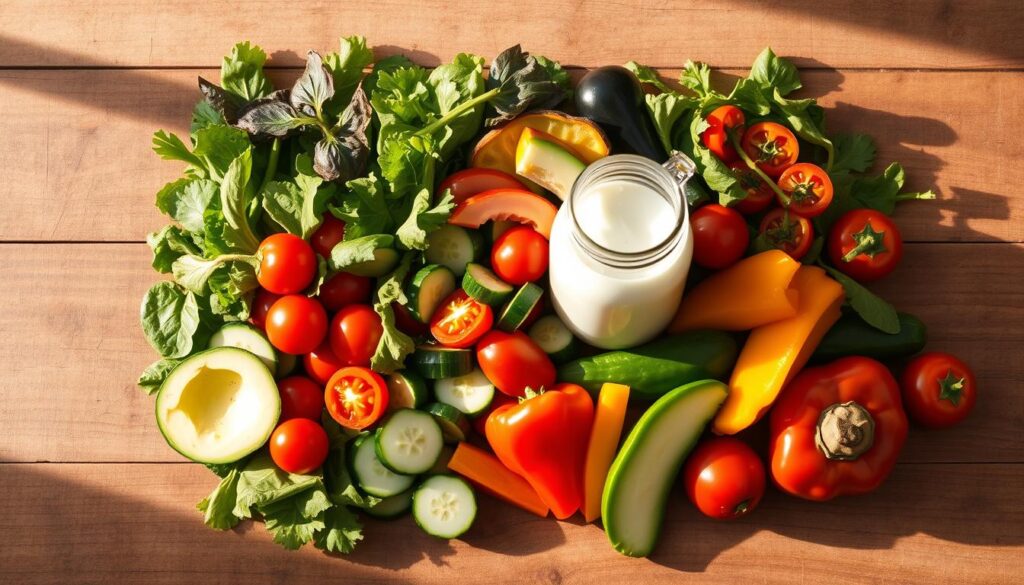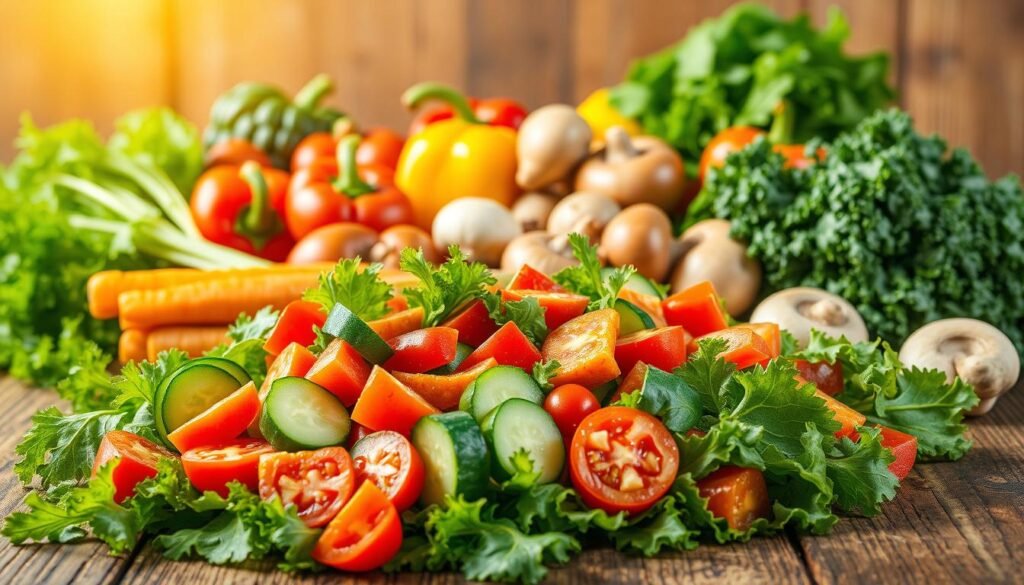Looking for a tasty and healthy lunch? Hearty vegetarian lunch salads are the perfect choice. These vibrant dishes are full of flavor and nutrients. They turn a simple salad into a tasty journey.
Nutritious salad recipes go beyond just lettuce and tomatoes. They mix whole grains, colorful veggies, protein-rich legumes, and unique ingredients. This mix keeps you full and energized all day. Plus, they’re ready in under 30 minutes, ideal for those with busy schedules.
These salads are great for anyone, whether you’re a vegetarian or just want to eat more plant-based. You’ll find everything from quinoa bowls to chickpea salads. They make healthy eating fun and exciting.
Key Takeaways
- Quick and easy vegetarian salads take less than 30 minutes to prepare
- Packed with diverse ingredients like chickpeas, quinoa, and fresh vegetables
- Provides balanced nutrition with high-protein plant-based options
- Versatile recipes suitable for meal prep and quick lunches
- Offers creative flavor combinations to keep meals interesting
Introduction to Hearty Vegetarian Lunch Salads
Discovering filling veggie salads can change your lunch from dull to amazing. Vegetarian meals have grown from simple greens to hearty, energizing options.
To make satisfying vegetarian meals, we need to know what makes salads great. Let’s dive into what makes a salad a hearty, tasty lunch.
What Makes a Salad Hearty?
A hearty salad is more than just greens. It has:
- Protein sources like legumes
- Diverse textures
- Nutrient-rich veggies
- Healthy fats for fullness
Benefits of Eating Vegetarian Salads
Vegetarian salads are great for your health. They give you important nutrients, help with weight, and boost energy. Studies show they can also improve digestion and help your long-term health.
“Eating a colorful, protein-rich salad can transform your midday meal into a nutritional powerhouse.” – Nutrition Expert
How to Make Salads Filling
To make salads filling, try these tips:
- Add protein-rich ingredients like beans or tofu
- Include whole grains for lasting energy
- Use healthy fats from nuts and seeds
- Try different vegetable textures
With these tips, you’ll make veggie salads that keep you full and healthy all day.
Essential Ingredients for Hearty Salads
Making tasty salads starts with knowing the key ingredients. In 2025, vegetarian salads focus on balance, nutrition, and exciting flavors. They keep you energized all day.
Leafy Greens: The Foundation of Healthy Lunch Ideas
Your salad’s base is crucial. Greens like spinach, kale, and arugula are packed with nutrients. Each green has its own benefits:
- Spinach: Rich in iron and vitamins
- Kale: Packed with antioxidants
- Arugula: Peppery flavor with calcium
Protein Sources for Plant-Powered Nutrition
Add protein to make your salad a full meal. Plant-based options are nutritious and filling:
| Protein Source | Nutritional Highlights |
|---|---|
| Chickpeas | 15g protein per cup, high fiber |
| Quinoa | 8g protein, complete amino acid profile |
| Tofu | 10g protein, calcium-rich |
Flavor Boosters and Texture Enhancers
Make your salad special with add-ins. Roasted nuts, crispy seeds, and fresh fruits add flavor and texture.
- Roasted pumpkin seeds for crunch
- Dried cranberries for sweetness
- Sunflower seeds for extra protein
“A great salad is a symphony of flavors, textures, and nutrients.” – Culinary Nutritionist
By mixing these ingredients, you’ll make salads that are both healthy and delicious. The secret is to experiment and find flavors you love!
Classic Hearty Vegetarian Salad Recipes
Discover three incredible plant-based lunch dishes that turn ordinary vegetables into flavorful veggie bowls. These recipes show that vegetarian salads can be both nourishing and exciting. They are packed with proteins, textures, and vibrant flavors.
Mediterranean Quinoa Salad
This colorful salad combines protein-rich quinoa with fresh Mediterranean ingredients. Your taste buds will enjoy the crisp vegetables and tangy feta cheese.
- Quinoa base for complete protein
- Fresh cucumber and tomatoes
- Crumbled feta cheese
- Kalamata olives
- Lemon-herb dressing
Chickpea Salad with Avocado
Creamy avocado meets protein-packed chickpeas in this satisfying vegetarian creation. The mix offers a delightful texture and nutritional punch.
| Ingredient | Quantity |
|---|---|
| Chickpeas | 1 cup |
| Ripe Avocado | 1 medium |
| Red Onion | 1/4 cup |
| Fresh Cilantro | 2 tablespoons |
Roasted Vegetable and Lentil Salad
Enjoy a warm, comforting salad that combines roasted vegetables with hearty lentils. This dish offers diverse flavors and textures perfect for a satisfying lunch.
“Eating plant-based doesn’t mean sacrificing flavor or satisfaction!” – Vegetarian Chef
Each recipe can be prepared in about 30 minutes. They are ideal for quick meal preparation. With an average of 5 main ingredients per salad, these dishes offer simplicity and nutrition in every bite.
Seasonal Ingredients for Hearty Salads
Creating nutritious salad recipes all year means using the best flavors each season has. By choosing seasonal produce, your meals will be more exciting and healthy.
Summer Salads with Fresh Vegetables
Summer is full of fresh, colorful veggies perfect for light salads. Your summer salad collection should include:
- Ripe tomatoes (featured in 37.9% of summer recipes)
- Cucumbers for cool crunch
- Sweet corn (used in 24.1% of summer recipes)
- Fresh herbs like basil and mint
Fall Ingredients to Embrace
When it gets cooler, your salads can get heartier. Try these fall favorites:
- Roasted butternut squash
- Crisp apples
- Toasted walnuts
- Dried cranberries
Winter Salads for Comfort
Winter salads can be warm and nutritious. Use ingredients that offer comfort and nutrition:
- Roasted root vegetables
- Citrus fruits for brightness
- Hearty greens like kale
- Warm quinoa or bulgur base
“Seasonal eating isn’t just about flavor—it’s about connecting with nature’s rhythms and nourishing yourself thoughtfully.”
By changing your ingredients with the seasons, your salads will stay interesting. You’ll also get a wide range of nutrients in your lunches.
| Season | Key Ingredients | Preparation Time |
|---|---|---|
| Summer | Tomatoes, Corn, Cucumbers | 15-20 minutes |
| Fall | Squash, Apples, Nuts | 25-30 minutes |
| Winter | Root Vegetables, Citrus, Kale | 30-45 minutes |
Creative Combos for Maximum Flavor
Exploring delicious salad options is more than just using traditional ingredients. Your vegetarian lunch can become a thrilling culinary journey. This is thanks to unexpected flavor combinations and global inspirations.
Discover flavorful veggie bowls that challenge your taste buds and nutritional expectations. The secret is to try unique ingredient pairings. These pairings will surprise and delight you.
Unconventional Ingredient Pairings
- Watermelon and feta cheese
- Strawberries with balsamic reduction
- Roasted peaches and goat cheese
- Pickled onions with fresh herbs
International Flavors to Explore
| Cuisine | Unique Ingredients | Flavor Profile |
|---|---|---|
| Korean | Kimchi | Spicy, tangy |
| Middle Eastern | Za’atar spice blend | Herbal, nutty |
| Indian | Curry spices | Warm, complex |
Texture Variations for Excitement
Create multi-dimensional salads by adding diverse textures. This makes every bite interesting:
- Crispy roasted chickpeas
- Toasted nuts for crunch
- Pickled vegetable garnishes
- Creamy avocado chunks
“Salads are a canvas for culinary creativity – don’t be afraid to mix unexpected ingredients!” – Vegetarian Chef Magazine
Remember, the most memorable salads tell a story. They do this through vibrant ingredients and innovative combinations.
Meal Prep Strategies for Hearty Salads
Preparing filling veggie salads ahead of time can change your meal planning. Meal prepping hearty vegetarian lunch salads saves time. It also ensures you have healthy meals all week.

Smart meal prep starts with keeping salads fresh and tasty. Proper storage techniques are key to maintaining salad quality.
Storing Salads for Maximum Freshness
To keep salads crisp, plan ahead. Here are some storage tips:
- Separate wet and dry ingredients until serving
- Use airtight containers to prevent moisture
- Store dressing separately to maintain salad texture
Ingredient Preparation Techniques
Advance preparation is key for filling veggie salads. Try these strategies:
- Roast vegetables in batches
- Cook grains ahead of time
- Prepare homemade dressings in advance
Choosing the Right Meal Prep Containers
| Container Type | Benefits | Best For |
|---|---|---|
| Glass Containers | Durable, Non-reactive | Hearty Salad Storage |
| Compartment Containers | Keeps Ingredients Separate | Preventing Sogginess |
| Leak-proof Containers | Prevents Spills | Transportable Meals |
Pro tip: Sturdy greens like dinosaur kale can be prepared days in advance without losing texture, making them perfect for meal prep.
Remember, the key to delicious meal-prepped salads is keeping ingredients fresh and separate until you’re ready to enjoy them!
Dressings That Elevate Your Salad
Dressings can turn simple salads into satisfying meals. They add depth, flavor, and excitement. The right dressing can make your salad unforgettable, turning it into a feast for your taste buds.
Making the perfect salad dressing is an art. It’s about finding the right mix of flavors and nutrition. Whether you’re cooking at home or love to experiment, learning to make great dressings can take your vegetarian meals to the next level.
Homemade Dressings to Experiment With
Homemade dressings are fresh and customizable. Here are some quick and tasty ideas:
- Classic Vinaigrette: 1/4 cup olive oil to 2 tablespoons vinegar
- Cilantro Lime Dressing: Fresh cilantro, lime juice, olive oil
- Creamy Caesar: Using ½ cup mayonnaise as a base
Store-Bought Options Worth Exploring
If you’re short on time, some store-bought dressings can still make your salads great.
| Brand | Sodium (mg) | Sugar (g) |
|---|---|---|
| Brianna’s French Vinaigrette | 270 | 3 |
| Generic Vinaigrette | 540 | 4 |
Balancing Flavors in Your Dressings
The key to a great dressing is balancing sweet, sour, salty, and umami. Emulsifiers like mustard and egg yolks help mix flavors smoothly. This makes your dressing blend well with your salad.
“A great dressing turns a simple salad into a culinary experience.” – Anonymous Chef
Try new herbs, adjust the mix, and be creative. Your dream dressing is just a whisk away!
Serving Suggestions and Pairings
Turning your hearty vegetarian salad into a full meal makes lunch more satisfying. With more people choosing plant-based options, it’s key to know how to pair your salad. This ensures a balanced and nutritious meal.
Perfect Sides to Complement Your Meal
Boost your healthy lunch with the right sides. These can make your meal more flavorful and nutritious. Here are some ideas:
- Whole grain bread or artisan crackers for added substance
- Roasted seasonal vegetables with minimal seasoning
- Small portions of quinoa or couscous
- Light vegetable soup as a warming complement
What to Serve with Your Salad
Your vegetarian salad can be the main attraction of a nutritionally complete lunch. The right sides make sure you get a meal that’s satisfying and keeps you going all afternoon.
*”A great salad is more than just greens—it’s a complete culinary experience.”*
Ideal Beverages for a Balanced Lunch
Drinking the right amount of water is important for enjoying your meal. Choose drinks that match your salad’s flavors:
- Herbal iced tea with fresh mint
- Infused water with cucumber or citrus
- Sparkling water with a splash of fruit juice
- Kombucha for a probiotic boost
With about 27% of U.S. adults eating less meat, these plant-based dishes are tasty and healthy. They don’t sacrifice taste or satisfaction.
Nutritional Considerations
Making nutritious salad recipes means knowing the nutritional value of your ingredients. It’s not just about mixing veggies. It’s about making a meal that’s good for your body.
Understanding the Nutritional Value
Dark, leafy greens are key in any salad. Kale, spinach, and mustard greens are full of vitamins and minerals. For example, kale has a lot of vitamin A and vitamins C and K.
- Spinach has 35% of daily iron
- Kale is rich in vitamins
- Leafy greens are full of important nutrients
Calories and Macronutrients in Salads
Knowing about macronutrients is important for healthy lunches. Different foods have different calorie counts:
| Nutrient | Calories per Gram | Key Sources |
|---|---|---|
| Protein | 4 | Tofu, beans, lentils |
| Carbohydrates | 4 | Sweet potatoes, corn, peas |
| Healthy Fats | 9 | Avocado, nuts, seeds |
How to Balance Macros in a Meal
To make healthy salads, choose ingredients wisely. Include:
- Protein source (beans, tofu)
- Complex carbohydrates (roasted veggies)
- Healthy fats (avocado, nuts)
- Many leafy greens
“Your salad should be a rainbow of nutrients, not just a pile of lettuce.”

By carefully picking ingredients, you make meals that are tasty and healthy. Eating salads regularly can cut down disease risks by up to 30%. So, every bite is good for your health.
Conclusion: Embrace Hearty Vegetarian Living
Your journey into hearty vegetarian lunch salads is more than a meal choice. It’s a lifestyle change that can improve your health and save money. By trying satisfying vegetarian meals, you might cut healthcare costs by 25% and reduce your carbon footprint a lot.
Trying plant-based nutrition opens up amazing culinary adventures. Salads with beans are full of protein and fiber, showing how tasty and healthy vegetarian meals can be. You’ll find new flavors that make your meals exciting and fulfilling.
This choice also benefits the planet and your wallet. By choosing hearty vegetarian lunch salads, you could save about $1,200 a year. Plus, you might feel more energetic by 17%. Your choice supports the environment and the economy too.
Your Culinary Adventure Awaits
Creating tasty vegetarian meals is a journey of discovery. Every salad you make is a chance to try new things. Stay curious, be creative, and enjoy the delicious world of vegetarian living.

